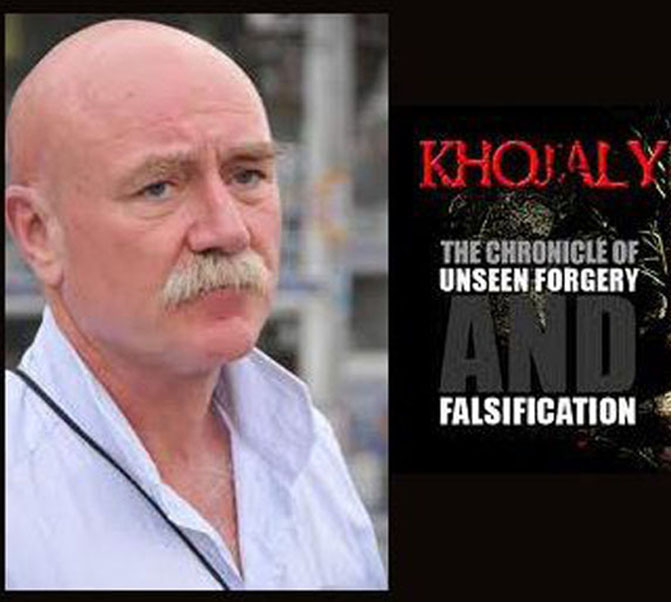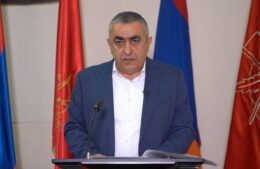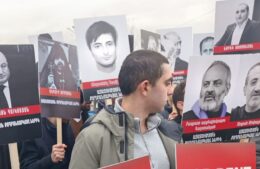Thomas Goltz: The Godfather of the Legend of the “Khojaly Genocide”
- (0)

Thomas Goltz: The Godfather of the Legend of the “Khojaly Genocide” –
By Vahram Atanesyan – Translated by Vartan Matiossian
Thomas Goltz. Born in Japan. Graduate of New York University, majoring in Near Eastern issues. He has been a journalist for fifteen years in Turkey and then in the former Soviet republics. He is the author of three books: “Azerbaijan Diary,” “Chechnya Diary,” “Georgia Diary.” He cooperates closely with Azerbaijani organizations of the U.S. and Canada (see http://ru.wikipedia.org)
He authored the first publication about the events of Khojaly in the international press. The Washington Post printed an article with his signature on February 27, 1992. Here it is:
“Officials of the main mosque in this town east of the embattled enclave of Nagorno Karabagh said they buried 17 bodies today [on February 27? V.A.], brought from an Azerbaijani town inside the enclave that was captured Wednesday by Armenian militiamen. Refugees fleeing the fighting in Khojaly, a town of 6,000 northeast of the enclave’s [Nagorno Karabagh. V.A.] capital, Stepanakert, claimed that up to 500 people, including women and children, were killed in the attack. No independent estimate of the death was available here [? V.A.]. The Agdam mosque’s director, Said Sadikov Muan, said refugees from Khojaly had registered the names of 477 victims with his mosque since Wednesday. Officials [who? V.A.] in Baku, the capital of Azerbaijan estimated the deaths in Khojaly at 100, while Armenian officials [who? V.A.] in their capital, Yerevan, said only two Azerbaijanis were killed in the attack. An official from Baku [who? V.A.] said here that his government fears Azerbaijanis would turn against it if they knew how many had been killed.
Of seven bodies seen here today [February 27? V.A.], two were children and three were women, one shot through the chest at what appeared to be close range. Another 120 refugees being treated at Agdam’s hospital include many with multiple stab [? V.A.] wounds.
The Armenians who attacked Khojaly Tuesday night were shooting, shooting, shooting,” said Raisa Aslanova [we will refer to this name again. V. A.], who reached Agdam Wednesday night. She said her husband and a son-in-law were killed and her daughter was missing.
Among the refugees who fled here [Agdam. V.A.] over the mountains of Nagorno Karabagh [? V.A.] were two Turkmen soldiers from former Soviet Interior Ministry forces who had taken refuge in Khojaly after deserting from their unit last Friday because, they said, Armenian non-commissioned officers had beaten them “from being Muslims.”
The two deserters claimed their former unit, the 366th Division [? V.A.], was supporting the Armenian militiamen who captured Khojaly. They said they tried to help women and children [from Khojaly. V.A.] escape. “We were bringing а group through the mountains when the Armenians found us and opened fire,” said Agamehmet Mutif, оnе of the deserters. “Twelve [of that group? V.A.] were killed.”[1]
Of seven bodies seen here today [February 27? V.A.], two were children and three were women, one shot through the chest at what appeared to be close range. Another 120 refugees being treated at Agdam’s hospital include many with multiple stab [? V.A.] wounds.
The Armenians who attacked Khojaly Tuesday night were shooting, shooting, shooting,” said Raisa Aslanova [we will refer to this name again. V. A.], who reached Agdam Wednesday night. She said her husband and a son-in-law were killed and her daughter was missing.
Among the refugees who fled here [Agdam. V.A.] over the mountains of Nagorno Karabagh [? V.A.] were two Turkmen soldiers from former Soviet Interior Ministry forces who had taken refuge in Khojaly after deserting from their unit last Friday because, they said, Armenian non-commissioned officers had beaten them “from being Muslims.”
The two deserters claimed their former unit, the 366th Division [? V.A.], was supporting the Armenian militiamen who captured Khojaly. They said they tried to help women and children [from Khojaly. V.A.] escape. “We were bringing а group through the mountains when the Armenians found us and opened fire,” said Agamehmet Mutif, оnе of the deserters. “Twelve [of that group? V.A.] were killed.”[1]
Let’s start from the end: Thomas Goltz “testifies” that two Turkmen deserters arrived in Agdam from Khojali. However, he considers them as “from former Soviet Interior Ministry forces.” Whereas it is know that the internal forces of the Ministry of Internal Affairs of the U.S.S.R. were evacuated in the fall of 1991. The American-Canadian “journalist” calls military unit 366 with the name of “division,” although it was not a completed regiment. He says that the two Turkmen soldiers “had taken refuge in Khojaly after deserting from their unit last Friday.” If it is correct that February 26, 1992 was a Wednesday, then the previous Friday was February 21. Was it possible that two Turkmen soldiers deserted the regiment 366 of Stepanakert and entered Khojaly on that day? Of course not, for the simple reason that, as it is said in the “Report” of the Ministry of National Security of Azerbaijan (see www.erevangala500.com) [2], “Armenian checkpoints have been installed in the entire surroundings of Khojaly, with exception of the direction to Askeran.” This document was written on February 11.
Besides, through this same source we get acquainted with the “testimony” oftwo deserters, one of them of Kazak nationality and the other Russian, who “deserted the regimen and reached Shushi, and then moved to Baku via Lachin-Kubatli.” Of course, we do not trust those “testimonies” either, because it was absolutely impossible that “the commander recruited mechanic-drivers from the regiment of Nakhijevan and brought them to Stepanakert via Ganja.” But Goltz’s story about the two Turkmen deserters and the abovementioned “testimonies” of the soldiers who went to the Azerbaijani side come to remind that the legend of the “participation” of the regiment 366 in the military operation of Khojaly is one of the components of the general “conception,” which was put into circulation immediately, on February 27, 1992.
It was necessary to use trustworthy means of communication to publish an article on the events of Khojaly in The Washington Post on that day, bearing in mind that in 1992 there was no electronic communication in Azerbaijan. It is also impossible that Goltz could have created telephone communication between Agdam and Washington. One must assume that he sent the material to Washington from Baku, where two countries had diplomatic representation at that moment: Iran and Turkey. It is likely that Thomas Goltz used the means of communication of the embassy of Turkey to send the first “hot” news to Washington. [3]
The weirdest thing is that no corpse of an inhabitant of Khojaly could be in Agdam on that day. The fact is that the first corpses reached Agdam by helicopter on February 28. Therefore, the story of “of seven bodies seen here today, two were children and three were women, one shot through the chest at what appeared to be close range” is pure invention. We repeat: the bodies of the dead were transported to Agdam later than Goltz wrote about them in The Washington Post as an “eyewitness.”
The charge of the “journalist” to the government of Azerbaijan in the piece of February 27 is very evident: “[F]ears Azerbaijanis would turn against it if they knew how many had been killed.” If his issue was just to make the American public aware of the events of Khojaly, why did he need to go deep inside the possible confrontation between government and people, particularly when he cites “an official from Baku”?
On March 1, the Sunday Times had already printed the following from Goltz’s pen:
It was necessary to use trustworthy means of communication to publish an article on the events of Khojaly in The Washington Post on that day, bearing in mind that in 1992 there was no electronic communication in Azerbaijan. It is also impossible that Goltz could have created telephone communication between Agdam and Washington. One must assume that he sent the material to Washington from Baku, where two countries had diplomatic representation at that moment: Iran and Turkey. It is likely that Thomas Goltz used the means of communication of the embassy of Turkey to send the first “hot” news to Washington. [3]
The weirdest thing is that no corpse of an inhabitant of Khojaly could be in Agdam on that day. The fact is that the first corpses reached Agdam by helicopter on February 28. Therefore, the story of “of seven bodies seen here today, two were children and three were women, one shot through the chest at what appeared to be close range” is pure invention. We repeat: the bodies of the dead were transported to Agdam later than Goltz wrote about them in The Washington Post as an “eyewitness.”
The charge of the “journalist” to the government of Azerbaijan in the piece of February 27 is very evident: “[F]ears Azerbaijanis would turn against it if they knew how many had been killed.” If his issue was just to make the American public aware of the events of Khojaly, why did he need to go deep inside the possible confrontation between government and people, particularly when he cites “an official from Baku”?
On March 1, the Sunday Times had already printed the following from Goltz’s pen:
“Survivors reported that Armenian soldiers shot and bayoneted mоrе than 450 Azeris, manу of them women, children. Hundreds, possibly thousands, were missing and feared dead. The attackers killed most of the soldiers and volunteers defending the women and children [? V.A.]. They then turned their guns оn the terrified refugees. The few survivors later described what happened: “That’s when the real slaughter began,” said Azer Hajiyev, оnе of three soldiers to survive. “The Armenians just shot and shot. And then they саmе in and started carving up people with their bayonets and knives.”
“They were shooting, shooting, shooting,” echoed Rasia Aslanova [the Raisa of the first article. V.A.], who arrived in Agdam with other women and children who made their way through Armenian lines [V.A.]. She said her husband, Кауun [? V.A.], and a son-in law were massacred in front of her. Her daughter was still missing.
One bоу who arrived in Agdam had an ear sliced off.
Тhе survivors said 2000 others, some of whom had fled separately, were still missing in the gruelling terrain; manу could perish from their wounds or the cold.
Ву late yesterday [February 28? V.A.], 479 deaths had been registered at the morgue in Agdam’s morgue, and 29 bodies had been buried in the cemetery. Of the seven corpses I saw awaiting burial, two were children and three were women, one shot through the chest at point blank range.
Agdam hospital was а scene of carnage and terror. Doctors said they had 140 patients who escaped slaughter, most with bullet injuries or deep stab wounds.
Nor were they safe in Agdam. Оn Friday night rockets fell оn the city which has а population of 150,000 [V.A.?], destroying several buildings and killing one person.” [4]
One bоу who arrived in Agdam had an ear sliced off.
Тhе survivors said 2000 others, some of whom had fled separately, were still missing in the gruelling terrain; manу could perish from their wounds or the cold.
Ву late yesterday [February 28? V.A.], 479 deaths had been registered at the morgue in Agdam’s morgue, and 29 bodies had been buried in the cemetery. Of the seven corpses I saw awaiting burial, two were children and three were women, one shot through the chest at point blank range.
Agdam hospital was а scene of carnage and terror. Doctors said they had 140 patients who escaped slaughter, most with bullet injuries or deep stab wounds.
Nor were they safe in Agdam. Оn Friday night rockets fell оn the city which has а population of 150,000 [V.A.?], destroying several buildings and killing one person.” [4]
As we see, the journalist has continuously exaggerated the situation. And this is his fatal mistake. Goltz has written on the dead as if everything had happened in Khojaly. “They саmе in and started carving up people with their bayonets and knives,” told him Raisa-Rasia Aslanova, whose “husband and a son-in-law were massacred in front of her.” On March 1 it was already known that people had been killed at a distance of fifteen kilometers from Khojaly, whereas Goltz has drawn scenes of “executed carnage” in Khojaly. Afterwards, he could have never seen 479 corpses in the morgue of Agdam. The reason is that just 181 corpses were actually subjected to forensic examination in Agdam.
It does not correspond to the truth either that the dead, supposedly, had knife wounds. The official conclusion of the forensic examination notes three kinds of wounds: firearm, projectile, and blunt instrument. The fact that Thomas Goltz presents Agdam, which had 25-30,000 inhabitants, as a “city which has a population of 150,000,” shows by itself that he penned his articles in Baku. Otherwise, why he should have made recourse to stupid exaggerations?
What was Goltz’s role? The answer comes from his Azerbaijan Diary. On March 5 we “see” him in the hall of the extraordinary session of the Supreme Soviet of Azerbaijan. The dialogue between Goltz and Elman Mahmedov, the mayor of Khojaly, is characteristic; when the “journalist” asks why he is worried, Mahmedov answers: “The film. They won’t show the film.” He referred to the footage ascribed to Jengiz Mustafayev, which was going to be shown as “exhibit” for Mutalibov’s resignation. It was shown on the same day, March 5, 1992.
Afterwards, we “meet” Goltz on May 14 of the same year, among the militants of the Popular Front of Azerbaijan attacking Mutalibov’s residence, together with the “press attache” of the embassy of Turkey in Baku. The remark of February 27, “his government fears Azerbaijanis would turn against it if they knew how many had been killed,” was not the prelude to that change of government? Was not the role of “international messenger” reserved to Goltz?
This is the Azerbaijani society’s problem. We have simply tried to prove, on the basis of proofs, that the information disseminated by Thomas Goltz on Khojaly has not even the slightest connection to reality.
What was Goltz’s role? The answer comes from his Azerbaijan Diary. On March 5 we “see” him in the hall of the extraordinary session of the Supreme Soviet of Azerbaijan. The dialogue between Goltz and Elman Mahmedov, the mayor of Khojaly, is characteristic; when the “journalist” asks why he is worried, Mahmedov answers: “The film. They won’t show the film.” He referred to the footage ascribed to Jengiz Mustafayev, which was going to be shown as “exhibit” for Mutalibov’s resignation. It was shown on the same day, March 5, 1992.
Afterwards, we “meet” Goltz on May 14 of the same year, among the militants of the Popular Front of Azerbaijan attacking Mutalibov’s residence, together with the “press attache” of the embassy of Turkey in Baku. The remark of February 27, “his government fears Azerbaijanis would turn against it if they knew how many had been killed,” was not the prelude to that change of government? Was not the role of “international messenger” reserved to Goltz?
This is the Azerbaijani society’s problem. We have simply tried to prove, on the basis of proofs, that the information disseminated by Thomas Goltz on Khojaly has not even the slightest connection to reality.
“Azg,” March 13, 2013
————————————
[1] Thomas Goltz, “Nagorno-Karabagh Victims Buried in Azerbaijani Town,”The Washington Post, February 28, 1992 (the article has the byline “Agdam, February 27” ).
[2] Azerbaijani website in Russian.
[2] Azerbaijani website in Russian.
[3] “Finally, I got a line through to the Moscow bureau of the Washington Postand said I wanted to file a story. The staffers there were too busy to take a dictation but reluctantly patched me through to the foreign desk in Washington when I insisted” (Thomas Goltz, Azerbaijan Diary, Armonk, 1998, p. 125).
[4] Thomas Goltz, “Armenian Soldiers Massacre Hundreds of Fleeing Families,” Sunday Times, March 1, 1992.


















